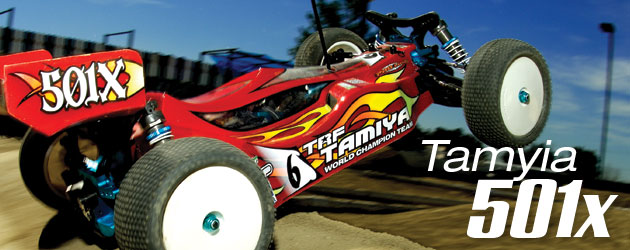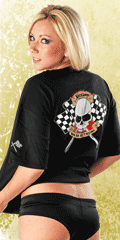|
Features
As I type this, the 501X already made the world take notice last
September by taking two of the top four spots in the JMRCA All-Japan
1/10 RC Off-road Championships. Take its midship motor layout and
smooth belt drive, add in Tamiya's experience in making race-winning
4WD vehicles (415MSX, anyone?), and you have a recipe for something
capable of taking over in the dirt.
Midship The layout of the 501X is derived from Tamiya's TA-05
platform, which features a mid-motor position. The center bulkhead is a
chunky, 3-piece sculpture made from anodized aluminum, featuring guide
bearings to keep the drive belts positioned correctly. The 501X's
center layshaft features a dual-disc slipper clutch sandwiching a
(surprise!) 48-pitch spur gear.
Heavy Duty The front and rear shock towers are made from
extra-thick 3.5 mm carbon fiber. This beefiness (if that's even a word)
is also apparent with the 2.5 mm thick upper and lower deck. The upper
deck consists of two separate carbon fiber plates, bridging the front
and rear bulkheads to the center bulkhead.
Lean Back Six ball bearings give the 501X a silky-smooth steering
rack. The entire rack rotates at a 15-degree angle in relation to the
lower deck. This eliminates bump-steer by matching the steering rack
angle to the caster angle of the front hubs. This lets both the wheel
and the steering rack pivot on the same axis.
Adjustable Adjustments True to any belt-driven performance vehicle,
the 501X uses a tabbed diff bearing mount to adjust belt tension. Front
and rear upper links have multiple mounting positions, and the steel
outdrive-equipped diffs sit captured within the multi-piece aluminum
bulkheads.
Call Me Cowboy The 501X uses a saddle-pack layout toward the rear to
distribute battery weight as close to the centerline of the chassis as
possible. Also, no tape is required for this one; two padded carbon
fiber plates hold the saddle pack snug in the recessed chassis.
Testing
I took the 501X to SoCal Raceway in Huntington Beach, CA for testing,
and to Revelation Raceway in Montclair for photos. When I got to SoCal,
one of the locals told me that the track's technical layout was a few
days fresh, with lots of jumps, turns, and whoops. The weather gave
some scattered showers(not that it mattered, since it's an indoor
facility), and that day there weren't that many people practicing, so I
had the track pretty much to myself.
Acceleration and Speed Once I got the slipper adjusted to the track
conditions, the 501X accelerated smooth and straight. Even on certain
uneven sections of the track where half of the lane had dips and bumps,
the 501X held firm. The gear ratio I was running felt a little on the
high side, but it had enough speed to fly down the straightaway. Here's
a good sign: whenever I pulled the trigger, I could barely hear any
noise from the 501X's dual belt drivetrain. Quiet is good.
Rating: 9/8
Braking Unlike other unspecified vehicles with less than optimal
drivetrain designs, the 501X had little drivetrain resistance. If I let
off the throttle at higher speeds, the 501X would eventually slow down,
but not as quickly as other vehicles I've driven. A quick jab at the
brake was all I needed to slow my speeds down entering a corner, but
holding the trigger forward would lock the 4 wheels up, and the buggy
would slow to a controlled, fade-free stop. Later I found myself using
the brake on the tighter corners to my advantage.
Rating: 8
Low-Speed Handling At low speeds, the suspension showed how soft it
was, as the chassis would lean with steering input. Maneuvering the
501X through the tighter sections of the track felt pretty good; it
didn't feel bland, nor did it feel too twitchy. Rear grip on turn exit
felt fine, as did the amount of steering I had while turning.
Rating: 9
High-Speed Handling Even with the Pro-Line tires on the 501X's
wheels, the 501X exhibited some understeer at higher speeds. This was
most evident through the chicane section and coming onto the front
straight; if I mashed the throttle down coming out onto the
straightaway, the 501X had a noticeable amount of understeer. This may
help by making the chassis more stable and less prone to spinouts, but
at the same time I had to keep tabs on my throttle input coming out of
certain corners. If I tried to go too fast, I'd see my outside wheels
right next to the side barriers on the track. I would have preferred to
see a little more steering incorporated in the kit-stock setup. TRF
factory driver Josh Numan was out there giving me some tips, and he
said that for a smaller, technical track like this, a simple switch to
a one-way up front would have given me more steering.
Rating: 7
Rough-Track Handling When I initially built the chassis, I had a
feeling that the suspension felt a little soft. On the rougher portions
of the track, this softness actually paid off by allowing the
suspension to absorb a lot of the rough stuff. The chassis would stay
level, and I could motor through certain rougher sections of the track
without the chassis losing composure. There was no hint of bump-steer,
thanks to the leaned-back steering rack design. I felt comfortable and
confident pushing the speeds higher on the rough stuff with the 501X,
cutting tighter lines when I could, without the chassis choosing its
own direction.
Rating: 9
Jumping The aforementioned suspension softness translated into
chassis-smacking landings if I overshot the medium-sized double jump.
The rear end always seemed to feel gravity before the front, and on
some short pops, the 501X would land rear wheels firstdoing a short,
un-steerable wheelie for about a foot before the front wheels got
enough grip to continue its course. I decided to experiment by trimming
the rear wing to cut down on downforce, and with this quick change the
chassis stayed level in the air. The 501X as a whole was pretty
consistent over the ramps.
Rating: 8
Wrenching
Maintenance With all of the required electronics in place, getting to
certain areas of the 501X may be tricky, especially the motor screws. I
ended up using 2.5mm screws, and the only way I can access them is by
using a ball-hex wrench, as there is no straight shot at the screws
with the ESC and receiver mounted on the right side of the chassis. My
ESC of choice didn't fit on the right side behind the motor, so I used
the alternate position, as specified in the manual. Also, although the
bulkheads are multi-piece, you still have to remove the carbon fiber
upper deck if you want to pull a diff out, as the upper deck is
literally sandwiched between the bulkhead halves.
Rating: 7.5
Wear and Tear The body undertray does its job keeping a lot of dirt
from getting onto the chassis and drivetrain. Coming off the middle
jump during photos, I managed to do a half-track cartwheel at least 3
times during the photo shoot, but there was no damage to be found. I
also hit the outside wall of the straightaway a couple of times, but
the 501X motored along unscathed. One side note make sure you cut a
small cooling vent in the body where your ESC is. I was running some
high-end equipment, and I ended up pushing the ESC into thermal mode
the first time I drove the track. I won't blame this on the 501X, but I
thought I'd share that info with you so you can prevent this from
happening on your ride.
Rating: 9
Tuning Tamiya knew that the die-hard racers would want as many
adjustments and tuning options as possible. Out of the box, the 501X's
upper links and shocks all have the requisite multiple mounting points.
A slipper clutch is standard equipment, and wheelbase is adjustable. I
kind of wished that there was a one-way included in the box (As of this
writing there are only a few hop up options available but knowing
Tamiya and looking at the 501X's design (aluminum suspension blocks,
separate upper arm mounts) that options list will expand in due time.
Rating: 8
Conclusion
Die-hard Tamiya fans were waiting for the day that Tamiya would get
serious about off-road as they did with touring car, and the 501X marks
the starting point. For being the first real competitive 4wd buggy in
years from the Tamiya camp, the design and features give it the
capability to run with the best of them. With good finishes already
under its belt during it's inaugural run, be sure that the 501X will
make a serious run, aiming for nothing but the top of the podium!
|
|
Manufacturer: Tamiya
Phone: 800.826.4922
Address: 2 Orion, Aliso Viejo, CA 92656








|
















